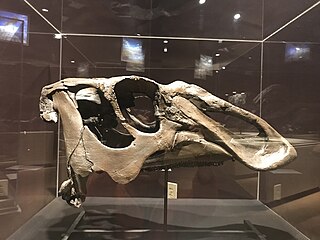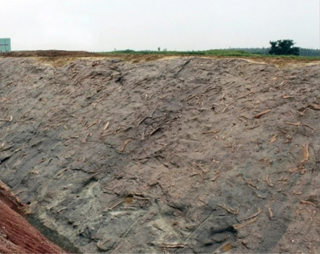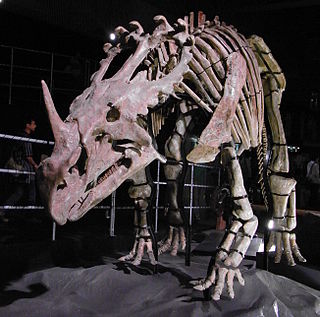
Hadrosaurus is a genus of hadrosaurid ornithopod dinosaurs that lived in North America during the Late Cretaceous Period in what is now the Woodbury Formation about 78-80 Ma. The holotype specimen was found in fluvial marine sedimentation, meaning that the corpse of the animal was transported by a river and washed out to sea.

Edmontosaurus, often colloquially and historically known as Anatosaurus or Anatotitan, is a genus of hadrosaurid (duck-billed) dinosaur. It contains two known species: Edmontosaurus regalis and Edmontosaurus annectens. Fossils of E. regalis have been found in rocks of western North America that date from the late Campanian age of the Cretaceous period 73 million years ago, while those of E. annectens were found in the same geographic region from rocks dated to the end of the Maastrichtian age, 66 million years ago. Edmontosaurus was one of the last non-avian dinosaurs to ever exist, and lived alongside dinosaurs like Triceratops, Tyrannosaurus, Ankylosaurus, and Pachycephalosaurus shortly before the Cretaceous–Paleogene extinction event.

Claosaurus is a genus of hadrosauroid dinosaur that lived during the Late Cretaceous Period (Santonian-Campanian).

Gryposaurus was a genus of duckbilled dinosaur that lived about 80 to 75 million years ago, in the Late Cretaceous of North America. Named species of Gryposaurus are known from the Dinosaur Park Formation in Alberta, Canada, and two formations in the United States: the Lower Two Medicine Formation in Montana and the Kaiparowits Formation of Utah. A possible additional species from the Javelina Formation in Texas may extend the temporal range of the genus to 66 million years ago.

Olorotitan was a monotypic genus of lambeosaurine duck-billed dinosaur, containing a single species, Olorotitan arharensis. It was among the last surviving non-avian dinosaurs to go extinct during the Cretaceous–Paleogene extinction event, having lived from the middle to late Maastrichtian-age of the Late Cretaceous era. The remains were found in the Udurchukan Formation beds of Kundur, Arkharinsky District, Amur Oblast, Eastern Russia, in the vicinity of the Amur River.

Barsboldia is a genus of large hadrosaurid dinosaur from the early Maastrichtian Nemegt Formation of Ömnogöv', Mongolia. It is known from a partial vertebral column, partial pelvis, and some ribs.

Mandschurosaurus is an extinct genus of hadrosaurids based on material from the Late Cretaceous of China and possibly also the Early Cretaceous of Laos. It was the first dinosaur genus named from China.

Kerberosaurus was a genus of saurolophine duckbill dinosaur from the late Maastrichtian-age Upper Cretaceous Tsagayan Formation of Blagoveshchensk, Amur Region, Russia. It is based on bonebed material including skull remains indicating that it was related to Saurolophus and Prosaurolophus.
Microhadrosaurus is a genus of hadrosaurid dinosaur from the Campanian or Maastrichtian-age Upper Cretaceous Yuanpu Formation of Guangdong, China. Although its name identifies it as a small hadrosaur, it is based on juvenile remains, and the size of the adult hadrosaur is unknown.

Prosaurolophus is a genus of hadrosaurid dinosaur from the Late Cretaceous of North America. It is known from the remains of at least 25 individuals belonging to two species, including skulls and skeletons, but it remains obscure. Its fossils have been found in the late Campanian-age Upper Cretaceous Dinosaur Park Formation in Alberta, and the roughly contemporaneous Two Medicine Formation in Montana, dating to around 75.5-74.0 million years ago. Its most recognizable feature is a small solid crest formed by the nasal bones, sticking up in front of the eyes.

Naashoibitosaurus is a genus of hadrosaurid dinosaur that lived about 73 million years ago, in the Late Cretaceous, and was found in the Kirtland Formation of the San Juan Basin in New Mexico, United States. Only a partial skeleton has been found to date. It was first described as a specimen of Kritosaurus by Jack Horner, and has been intertwined with Kritosaurus since its description.

Edmontosaurini are a tribe of saurolophine hadrosaur dinosaurs that lived in the Northern Hemisphere during the Late Cretaceous period. It currently contains Edmontosaurus, Shantungosaurus and Laiyangosaurus, and Kamuysaurus. Kerberosaurus and Kundurosaurus from Russia could also be members, though they are more likely saurolophins.
Nanningosaurus is a genus of hadrosaurid dinosaur from the upper Late Cretaceous of the Nalong Basin, Guangxi, China.

Edmontosaurus regalis is a species of comb-crested hadrosaurid dinosaur. Fossils of E. regalis have been found in rocks of western North America that date from the late Campanian age of the Cretaceous Period 73 million years ago, but it may have possibly lived into the early Maastrichtian.

Edmontosaurus annectens, often colloquially and historically known as the Anatosaurus, is a species of flat-headed saurolophine hadrosaurid dinosaur from the late Maastrichtian age at the very end of the Cretaceous period, in what is now western North America. Remains of E. annectens have been preserved in the Frenchman, Hell Creek, and Lance Formations. All of these formations are dated to the late Maastrichtian age of the Late Cretaceous period, which represents the last three million years before the extinction of the dinosaurs. E. annectens is also found in the Laramie Formation and magnetostratigraphy suggests an age of 69-68 Ma for the Laramie Formation. Edmontosaurus annectens is known from numerous specimens, including at least twenty partial to complete skulls, discovered in the U.S. states of Montana, South Dakota, North Dakota, Wyoming, and Colorado, as well as the Canadian province of Saskatchewan. It had an extremely long and low skull and was quite a large animal, growing up to approximately 12 metres (39 ft) in length and 5.6 metric tons in average asymptotic body mass, although it could have been even larger. E. annectens exhibits one of the most striking examples of the "duckbill" snout that is common to hadrosaurs. It has a long taxonomic history and specimens have at times been classified as Diclonius, Trachodon, Hadrosaurus, Claosaurus, Thespesius, Anatosaurus, and Anatotitan before all being grouped together in Edmontosaurus

The Wangshi Group is a geological Group in Shandong, China whose strata date back to the Coniacian to Campanian stages of the Late Cretaceous. Dinosaur remains are among the fossils that have been recovered from the group.

Sinoceratops is an extinct genus of ceratopsian dinosaur that lived approximately 73 million years ago during the latter part of the Cretaceous Period in what is now Shandong province in China. It was named in 2010 by Xu Xing et al. for three skulls from Zhucheng, China. The name of its type species Sinoceratops zhuchengensis means "Chinese horned face from Zhucheng", after the location of its discovery.

Ankylopollexia is an extinct clade of ornithischian dinosaurs that lived from the Late Jurassic to the Late Cretaceous. It is a derived clade of iguanodontian ornithopods and contains the subgroup Styracosterna. The name stems from the Greek word, “ankylos”, mistakenly taken to mean stiff, fused, and the Latin word, “pollex”, meaning thumb. Originally described in 1986 by Sereno, a most likely synapomorphic feature of a conical thumb spine defines the clade.

Kundurosaurus is an extinct genus of saurolophine hadrosaurid dinosaur known from the Latest Cretaceous of Amur Region, Far Eastern Russia. It contains a single species, Kundurosaurus nagornyi.

This timeline of hadrosaur research is a chronological listing of events in the history of paleontology focused on the hadrosauroids, a group of herbivorous ornithopod dinosaurs popularly known as the duck-billed dinosaurs. Scientific research on hadrosaurs began in the 1850s, when Joseph Leidy described the genera Thespesius and Trachodon based on scrappy fossils discovered in the western United States. Just two years later he published a description of the much better-preserved remains of an animal from New Jersey that he named Hadrosaurus.




























